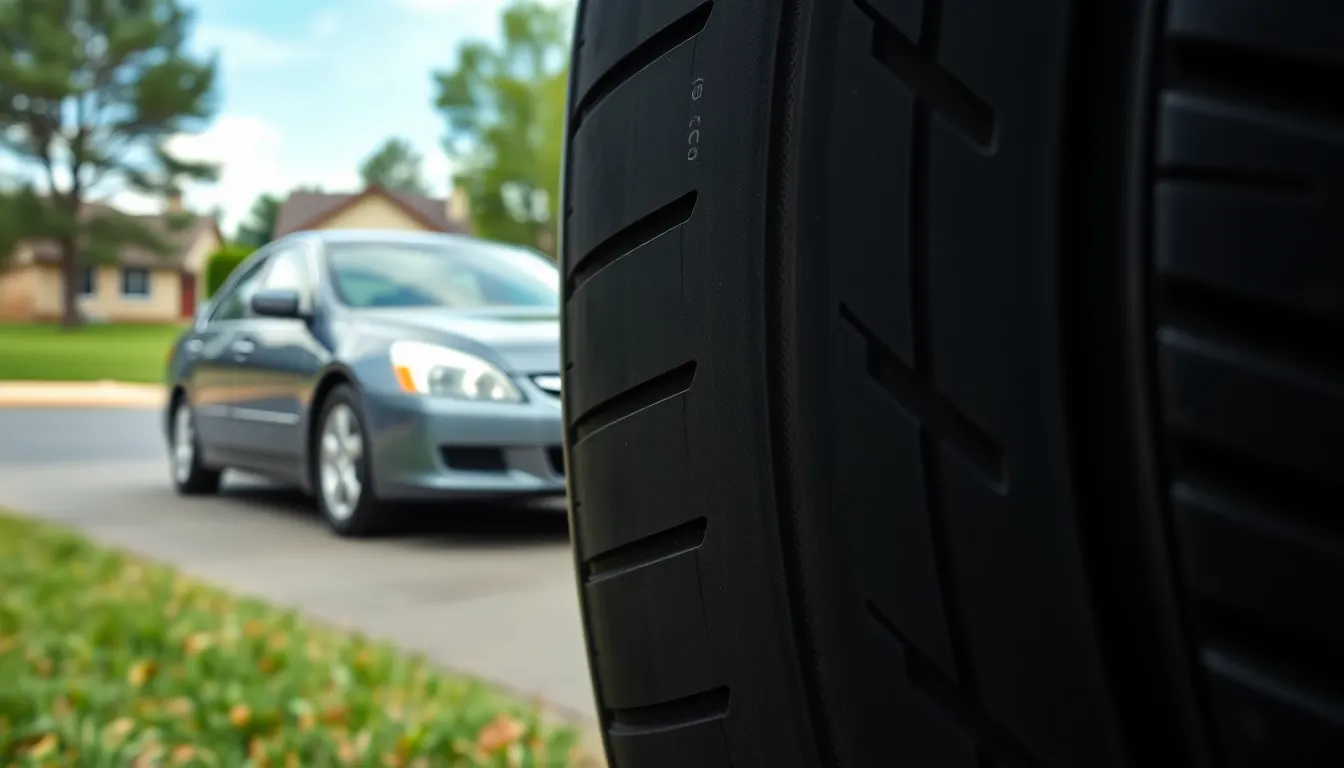Finding the right tire size for your 2004 Honda Accord shouldn’t be a guessing game. We’ve all been there – standing in the tire shop feeling overwhelmed by numbers and letters that seem like a foreign language. The wrong tire choice can affect your vehicle’s performance, fuel economy, and safety.
Your 2004 Accord came with exact tire specifications from the factory, and understanding these numbers is crucial for making informed decisions. Whether you’re replacing worn tires or considering an upgrade, knowing the correct size ensures optimal handling and maintains your warranty coverage.
We’ll break down everything you need to know about 2004 Honda Accord tire sizes, from decoding those confusing sidewall markings to exploring compatible alternatives. You’ll discover how tire size impacts your driving experience and learn to make confident choices that keep your Accord running smoothly for years to come.
2004 Honda Accord Original Tire Specifications
The 2004 Honda Accord came equipped with different tire sizes depending on the exact trim level and configuration. Understanding these original equipment manufacturer (OEM) specifications helps us determine the proper replacement tires for maintaining optimal performance and safety.
Standard Tire Sizes by Trim Level
LX models came equipped with 195/65R15 tires as the standard configuration. This size provides a balanced combination of comfort and fuel efficiency for daily driving needs.
EX trim levels featured 205/60R16 tires as their factory specification. These tires offer improved performance characteristics while maintaining reasonable comfort levels for most drivers.
EX-L and Hybrid variants utilized 205/55R16 tires from the factory. The lower profile design enhances handling response and provides a more sporty appearance compared to higher sidewall options.
| Trim Level | Standard Tire Size | Sidewall Height | Performance Focus |
|---|---|---|---|
| LX | 195/65R15 | 65 series | Comfort/Economy |
| EX | 205/60R16 | 60 series | Balanced Performance |
| EX-L/Hybrid | 205/55R16 | 55 series | Sport/Handling |
Wheel Diameter and Width Options
Factory 15-inch wheels measured 6.5 inches in width and paired exclusively with LX models. These wheels provide adequate strength for daily driving while keeping replacement costs reasonable.
Standard 16-inch wheels featured a 6.5-inch width across EX and EX-L trim levels. The larger diameter improves braking performance and allows for lower profile tire options that enhance handling characteristics.
Optional 17-inch wheels became available on certain EX-L configurations with a 7-inch width. These wheels accommodate 215/50R17 tires and deliver enhanced cornering stability for drivers seeking improved performance capabilities.
Bolt pattern specifications remained consistent at 5×114.3mm across all trim levels. The hub bore measured 64.1mm diameter while wheel offset typically ranged from +50mm to +55mm depending on the exact wheel design.
Performance Impact of Different Tire Sizes

Changing tire sizes on your 2004 Honda Accord creates measurable differences in vehicle performance across multiple areas. We examine how width, profile, and overall diameter modifications affect your driving experience and vehicle efficiency.
Fuel Economy Considerations
Larger tires increase rolling resistance, which directly reduces fuel efficiency in your Honda Accord. The factory 195/65R15 tires on LX models optimize fuel economy through reduced contact patch and lower rolling resistance compared to wider alternatives.
Tire Size and Fuel Efficiency: Moving from 195/65R15 to 205/60R16 tires typically decreases fuel economy by 2-4% due to increased rolling resistance. Upgrading to 215/50R17 sizes can reduce efficiency by 5-7% compared to the base tire size.
Tire Pressure Impact: Proper inflation maintains optimal fuel efficiency regardless of tire size. Underinflated tires increase rolling resistance by up to 15%, making pressure monitoring essential for any tire configuration on your Accord.
Narrower tires like the 195/65R15 specification deliver better fuel economy but may compromise wet weather performance. Wider options such as 205/60R16 provide enhanced grip at the expense of increased fuel consumption.
Handling and Ride Quality Changes
Tire width significantly affects cornering performance and steering response in your 2004 Honda Accord. Moving from 195mm width to 205mm or 215mm widths improves lateral grip and reduces body roll during cornering maneuvers.
Sidewall Aspect Ratio Effects: The 65 aspect ratio in 195/65R15 tires provides a comfortable ride through increased sidewall flex. Lower ratios like the 50 series in 215/50R17 configurations improve handling precision but create a firmer ride quality.
Tire Width Performance: Wider tires such as 205/60R16 deliver better dry traction and cornering stability than the base 195/65R15 size. But, increased width can reduce ride comfort due to enhanced road feedback transmission.
Different tread patterns affect noise levels and traction characteristics regardless of tire size. All season tread designs balance performance across weather conditions while performance oriented patterns prioritize dry grip over comfort considerations.
Popular Tire Size Upgrades for 04 Honda Accord

Many 2004 Honda Accord owners explore tire size upgrades to enhance their vehicle’s performance and appearance. These modifications, commonly called plus sizing, involve increasing wheel diameter while maintaining overall tire diameter through lower profile sidewalls.
Plus Sizing Benefits and Drawbacks
Plus 1 upgrades transform the standard 195/65R15 configuration to 205/55R16 or 205/60R16 sizes. These modifications deliver improved handling characteristics and enhanced steering responsiveness during cornering maneuvers.
Plus 2 configurations upgrade 205/60R16 tires to 225/45R17 dimensions. Drivers experience significantly better stability at highway speeds and more precise steering feedback through these larger contact patches.
Plus 3 transformations move smaller factory sizes to 215/50R17 specifications. These comprehensive upgrades provide the most dramatic improvement in handling performance and visual appeal.
| Upgrade Type | Benefits | Drawbacks |
|---|---|---|
| Plus 1 | Improved handling, Enhanced appearance | Potential noise increase, Higher replacement costs |
| Plus 2 | Better stability, Increased fuel efficiency | Speedometer accuracy impact, Vibration concerns |
| Plus 3 | Maximum performance, Optimal aesthetics | Highest cost, Greatest comfort compromise |
Enhanced appearance ranks among the primary motivations for plus sizing upgrades. Larger wheels fill wheel wells more completely and create a sportier visual profile that appeals to performance enthusiasts.
Increased noise and vibration represent the most common drawbacks of plus sizing modifications. Lower profile sidewalls transmit more road imperfections to the cabin and reduce overall ride comfort compared to factory configurations.
Recommended Upgrade Options
DX and LX models benefit most from 205/60R16 upgrades that improve handling without compromising ride quality significantly. These modifications maintain compatibility with existing suspension components while delivering noticeable performance improvements.
EX models accommodate 215/50R17 upgrades that maximize both performance enhancement and aesthetic appeal. These larger configurations complement the EX trim’s sportier character and provide substantial handling improvements over factory specifications.
Wheel well clearance verification becomes essential before implementing any plus sizing upgrade. Suspension travel and steering lock positions must accommodate larger tire dimensions to prevent contact issues during normal driving conditions.
Professional consultation ensures proper fitment and maintains vehicle safety standards throughout the upgrade process. Certified technicians verify load ratings, speed ratings, and dimensional compatibility before installation completion.
How to Choose the Right Tire Size

Selecting the correct tire size for your 2004 Honda Accord requires understanding your vehicle’s exact requirements and reading tire specifications accurately. We’ll guide you through the essential steps to ensure optimal performance and safety.
Reading Your Current Tire Sidewall
The sidewall of your current tires contains all the information you need to identify the correct replacement size. Looking at a tire marked “205/60R16” reveals exact measurements that determine fitment and performance characteristics.
Tire Size Components:
| Component | Example | Meaning |
|---|---|---|
| Width | 205 | Tire width in millimeters |
| Aspect Ratio | 60 | Sidewall height as percentage of width |
| Construction | R | Radial construction type |
| Rim Diameter | 16 | Wheel diameter in inches |
Additional markings on the sidewall include the speed rating (such as H or V), load index numbers, and DOT codes indicating manufacture dates. These specifications directly impact your vehicle’s handling characteristics and safety performance.
Speed ratings indicate the maximum sustained speed capability, while load indexes specify weight-carrying capacity. DOT codes help determine tire age, which affects replacement timing regardless of tread wear.
Compatibility and Safety Factors
Matching your 2004 Honda Accord’s Original Equipment Manufacturer specifications ensures proper vehicle operation and safety compliance. Different trim levels require exact tire sizes that Honda engineered for optimal performance.
OEM Size Requirements by Trim:
| Trim Level | Engine | Required Size |
|---|---|---|
| DX Sedan | 4-cylinder | 195/65R15 |
| LX Sedan | 4-cylinder | 205/65R15 |
| LX/EX Sedan | V6 | 205/60R16 |
| EX Coupe | V6 6-Speed | 215/50R17 |
Speed and load ratings must meet or exceed your vehicle’s original specifications for safe operation. Installing tires with lower ratings can compromise braking performance and handling stability.
Wheel specifications including rim diameter, width, and bolt pattern require exact matching for proper fitment. Your 2004 Accord uses exact bolt patterns and hub bore measurements that ensure secure mounting and proper wheel alignment.
Seasonal considerations affect tire selection based on your climate conditions. All-season tires provide balanced performance across weather conditions, while winter tires offer superior cold-weather traction at temperatures below 45°F.
Always verify the door jamb label or consult your owner’s manual before purchasing replacement tires to confirm the exact specifications for your exact trim and engine combination.
Installation and Maintenance Tips

Proper installation and ongoing maintenance maximize the performance and lifespan of your 2004 Honda Accord tires. Following these essential practices ensures optimal safety and cost effectiveness.
Professional vs DIY Installation
Professional installation delivers superior results through certified technicians who use specialized equipment and proven expertise. ASE certified mechanics at Goodyear Auto Service and similar establishments mount tires correctly, balance wheels precisely, and align systems properly to prevent uneven wear patterns. These professionals complete the service efficiently while ensuring safety standards are met throughout the process.
DIY installation remains possible for experienced individuals with proper tools and mechanical knowledge. Risks include improper mounting techniques, wheel imbalance issues, and potential damage to tires or rims during the process. Most automotive experts recommend professional installation to avoid costly mistakes and ensure warranty coverage remains valid.
Proper Tire Care and Rotation
Tire rotation promotes even wear distribution and extends overall tire life for your Honda Accord. Front to back rotation patterns work best every 5,000 to 7,500 miles, following the exact schedule recommended in your owner’s manual. This maintenance practice prevents premature replacement and maintains consistent traction across all four positions.
Regular pressure checks ensure optimal performance and fuel economy for your Accord’s tires. Check the door jamb label for manufacturer specified PSI levels, typically ranging from 30 to 35 PSI depending on your trim level. Underinflated tires increase rolling resistance and reduce fuel efficiency by up to 10% while causing accelerated wear patterns.
Visual inspections catch potential problems before they become safety hazards or costly repairs. Examine tread depth using the penny test, look for embedded objects like nails or screws, and check sidewalls for cracks or bulges. Monitor wear patterns that indicate alignment issues, with uneven wear suggesting the need for professional wheel alignment service.
Wheel alignment and balancing maintenance occurs annually or when vibration and uneven wear become noticeable. Proper alignment ensures your Accord tracks straight and tire contact patches remain optimal for traction and longevity. Balancing eliminates vibrations that cause driver fatigue and premature tire wear, particularly important for the larger wheel sizes found on EX and EX-L trim levels.
Conclusion
Getting the right tire size for your 2004 Honda Accord isn’t just about following manufacturer specs—it’s about understanding how each choice affects your daily driving experience. We’ve covered everything from factory specifications to upgrade options and the real-industry impact on fuel economy and handling.
Whether you stick with OEM sizes or explore plus sizing options your decision should align with your driving priorities and budget. Remember that proper installation and regular maintenance will maximize whatever tire choice you make.
The key takeaway? Don’t overlook the importance of professional guidance when making important changes to your tire setup. Your 2004 Accord deserves tires that enhance both safety and performance while delivering the driving experience you want.
Frequently Asked Questions
What are the original tire sizes for a 2004 Honda Accord?
The original tire sizes vary by trim level. LX models come with 195/65R15 tires for comfort and fuel efficiency. EX trim levels feature 205/60R16 tires for improved performance. EX-L and Hybrid variants use 205/55R16 tires, offering enhanced handling and a sportier appearance. Each size is specifically chosen to balance performance, comfort, and fuel economy for that particular trim.
How does tire size affect fuel economy in a 2004 Honda Accord?
Larger tires increase rolling resistance, reducing fuel economy. Moving from factory 195/65R15 to 205/60R16 tires may decrease fuel efficiency by 2-4%. Upgrading to 215/50R17 sizes can reduce it by 5-7%. Additionally, proper tire inflation is crucial – underinflated tires significantly increase rolling resistance and worsen fuel economy regardless of size.
What is plus sizing and what are the benefits?
Plus sizing involves increasing wheel diameter while maintaining overall tire diameter through lower profile sidewalls. Benefits include improved handling, better steering response, enhanced stability, and more attractive aesthetics. Common options include Plus 1 (205/55R16), Plus 2 (225/45R17), and Plus 3 (215/50R17). However, it may increase noise, cost, and reduce ride comfort.
How do I read tire size markings on my 2004 Honda Accord?
Tire size markings follow a standard format like 195/65R15. The first number (195) is width in millimeters, the second (65) is aspect ratio (sidewall height as percentage of width), “R” indicates radial construction, and the final number (15) is rim diameter in inches. Additional markings include speed ratings and load indexes for safety specifications.
Should I install tires myself or use a professional?
Professional installation is recommended for safety and precision. Professionals have proper equipment for mounting, balancing, and ensuring correct pressure. DIY installation carries risks of improper mounting, potential damage, and safety hazards. While DIY may save money, professional installation ensures optimal performance, safety standards, and often includes warranties on the work performed.
How often should I rotate tires on my 2004 Honda Accord?
Tire rotation should be performed every 5,000-7,500 miles or as specified in your owner’s manual. Regular rotation ensures even wear patterns, extends tire lifespan, and maintains optimal traction. The rotation pattern depends on whether you have directional or non-directional tires. Consistent rotation helps prevent premature replacement and maintains balanced handling characteristics.
What maintenance is required after installing new tires?
Essential maintenance includes monthly pressure checks, regular visual inspections for damage or uneven wear, and tire rotation every 5,000-7,500 miles. Annual wheel alignment and balancing prevent uneven wear and ensure optimal traction. Monitor tread depth regularly and replace tires when they reach 2/32″ depth. Proper maintenance maximizes tire performance, safety, and lifespan.

